
|
* Information contained in this news release is current as of its date of announcement. Be aware that information contained herein is subject to change without notice. |
The Energy Management System at the Heart of Kashiwa-no-ha Smart City
Kashiwa-no-ha AEMS and Kashiwa-no-ha HEMS developed, implementation to be phased in from May 2014
Supporting energy conservation, disaster response, and community activities at the “town” and “residence” levels
April 24, 2014
Hitachi, Ltd.
Sharp Corporation
Mitsui Fudosan Co., Ltd.
Nikken Sekkei Ltd.
Mitsui Fudosan Co., Ltd. (“Mitsui Fudosan”), in association with Hitachi, Ltd. (“Hitachi”), Sharp Corporation (“Sharp”), and Nikken Sekkei Ltd. (“Nikken Sekkei”) have announced today the development of Kashiwa-no-ha AEMS*1 for energy management, monitoring, and control for the entire town, and Kashiwa-no-ha HEMS*2, for managing energy within residences. The two systems will form the core system for supporting energy conservation, disaster response, and community activities in Kashiwa-no-ha Smart City, (Kashiwa City, Chiba Prefecture), and will be phased in from the middle of May 2014.
Kashiwa-no-ha AEMS (patent applied for*3) was developed by Hitachi together with Mitsui Fudosan and Nikken Sekkei. The system will link the facilities distributed in the area, such as offices, retail properties, hotels, and residences, with electric power facilities including solar power generation and power storage in a network to conduct centralized energy management for the area. It carries out efficient control of power generation, storage, and electrical interchange for the entire town, based on an accurate grasp and analysis of energy usage at each facility, weather information, and other data. As a result, it will realize reduced electricity charges and CO2 emissions, and maintain electric power in a disaster. Moreover, in the future the Kashiwa-no-ha AEMS is also to be linked with the transportation system*4 and other systems operated in Kashiwa-no-ha Smart City to form a town information linking platform to manage all information in the area.
In collaboration with Mitsui Fudosan, Sharp has also developed the Kashiwa-no-ha HEMS, which will link with the Kashiwa-no-ha AEMS. The HEMS visualizes energy usage status within a residence, and also controls electrical appliances and offers energy conservation advice to suit users’ lifestyles. The system also links with the AEMS to compare the household energy conservation with that of other households and the entire town to enable users to accumulate Kashiwa-no-ha Points*5, an area-based point system, depending on how well they conserve energy. The link with AEMS also provides information on local events, transport information, and disaster information in the event of a disaster. The information can be accessed using a dedicated HEMS tablet device.
The Kashiwa-no-ha AEMS will be centrally controlled from the Kashiwa-no-ha Smart Center, (trial operation scheduled for June 2014, full operation from July 2014), which will be established in the mixed-use facility Gate Square, which is currently under development in Kashiwa-no-ha Smart City. The system will be implemented across an area of approximately 12.7 hectares, including peripheral districts. A system for attributing points (dynamic incentive) to Gate Square offices and tenants according to their contribution to annual CO2 reductions and power peak shaving via the Kashiwa-no-ha AEMS will also be introduced. Meanwhile, the Kashiwa-no-ha HEMS will be installed in the Park Access Kashiwa-no-ha rental residences (total units: 145, residents to begin occupation in May 2014) in Gate Square. The newly developed AEMS and HEMS will be used to operate a smart grid in Kashiwa-no-ha Smart City, combining local energy in the form of distributed power supplies, including large-scale introduction of solar power generation, gas power generation, and storage battery systems, with grid power provided by power companies.
Kashiwa-no-ha Smart City Energy Management System Features
- Links residences, offices, and retail properties throughout the entire town to visualize energy and community information
- Conducts electrical interchange between facilities that have different peak usage times to achieve peak cuts and reduce power service charges and CO2 emissions
- Shares energy across the entire town so that daily life and business activities can continue during disasters and power cuts
- Provides residents and facilities with specific advice on conserving energy according to the state of energy usage
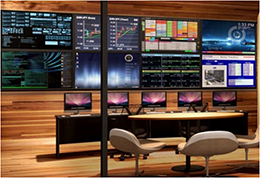
Kashiwa-no-ha Smart Center (Artist’s impression)
|
 |
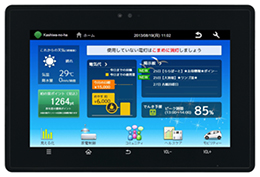
Kashiwa-no-ha HEMS tablet device (Artist’s impression) |
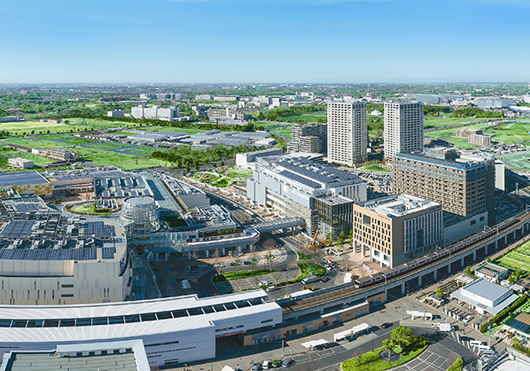
Aerial photograph of Kashiwa-no-ha Smart City
System Network Diagram of Kashiwa-no-ha AEMS and Kashiwa-no-ha HEMS
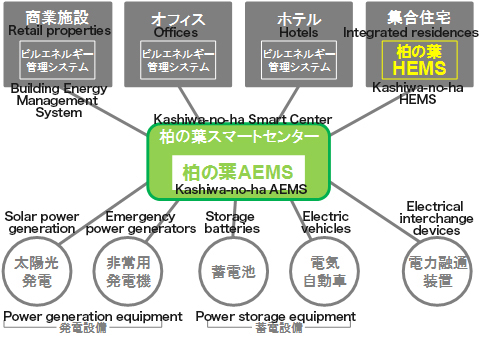
Roles of Companies
- Hitachi, Ltd.
- Construction of the Kashiwa-no-ha AEMS and operational support. Design and manufacture of lithium-ion storage battery system, electrical interchange equipment, transformer equipment, and large-size multi-vision display system
- Sharp Corporation
- Construction of Kashiwa-no-ha HEMS system and operational support
- Mitsui Fudosan Co., Ltd.
- Formulation and promotion of the overall construction concept of Kashiwa-no-ha Smart City, determining requirements for energy management, and implementation and operation of Kashiwa-no-ha AEMS and Kashiwa-no-ha HEMS
- Nikken Sekkei Ltd.
- Collaboration with Nikken Sekkei Research Institute on concept proposals for environmental, energy, BCP*6 and LCP*7, and ICT-related aspects of the project. Technical advice, system implementations, and other consulting services for realizing the Smart City concept
Winner of the Good Design Award 2013
The Kashiwa-no-ha AEMS and Kashiwa-no-ha HEMS were both recognized for their high quality of design when they received the Good Design Award 2013 from the Japan Institute of Design Promotion.
Kashiwa-no-ha AEMS Main Functions and Screen Images
- Energy management for the entire town
Conventional energy management is conducted at the level of individual facilities, but AEMS is designed to optimally manage and control energy across an entire area. To do this, AEMS centrally manages the area’s energy usage as well as its solar power generation, storage batteries, electrical interchange equipment, and other elements, while estimating the power requirements of each facility. AEMS achieves peak cuts by conducting electrical interchange between facilities with different peak usage periods, such as offices and retail properties. This reduces the amount of contracted power supply, along with the associated services charges, and helps to reduce the CO2 emissions of the entire town. At the same time, AEMS proposes specific measures to conserve energy to offices and retail tenants according to their energy usage status.
- Stable control of renewable energy and area energy supply during disasters
Solar power generation volume fluctuates depending on the weather. This power can be combined with storage batteries and controlled through the AEMS to deliver a stable supply of renewable energy. In the event of a major power cut, the AEMS systematically interchanges energy sources across the entire town to maintain lifeline facilities so that businesses and daily living can continue. At the same time, the AEMS delivers emergency information such as evacuation guidance to support the safety and security of the town.
- Area resource management system that evolves in step with town development
Kashiwa-no-ha Smart City is currently operating a multi-transport sharing system that includes electric vehicles (EV), electric motorcycles, and other equipment. Plans call for the AEMS to be linked with this transport system, and to manage the remaining battery charge in the EVs and their current position. During a power cut, the AEMS will make effective use of the EV batteries as an emergency power source, and take other measures to contribute to area disaster plans. The AEMS is also to be linked with various systems operated in Kashiwa-no-ha Smart City, such as the area information system, and will be used as an area information linking platform to support the activities of the entire town.
Energy manager (Smart Center) screen images
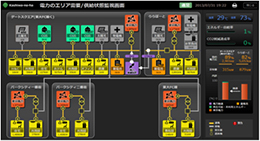
Screen for monitoring the energy status of the entire town
|
 |
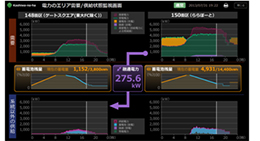
Screen for ascertaining the energy supply and demand for each facility, and the electricity interchange volume |
Office and retail tenant user screen images
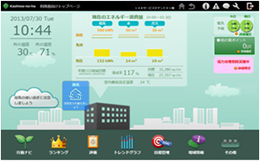
Home screen for checking current energy consumption and progress on target achievement
|
 |
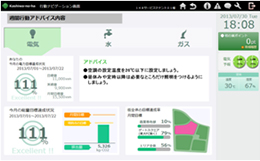
Action navigation screen for checking specific energy conservation advice |
Main Functions and Screen Images of Kawshiwa-no-ha HEMS
- Simple operation for realizing comfortable energy conservation
The system uses tablets devices, smartphones, or PCs, to vizualize electricity, water, and hot water usage within a residence. Electricity usage information can be checked not only for the entire residence, but for each household appliance, enabling users to see the energy-saving status of each appliance. Moreover, an artificial intelligence (AI) function will be included to offer users specific advice on measures for conserving energy without sacrificing comfort, based on their lifestyle patterns. The AI function can also control household appliances. This function not only adjusts each appliance individually, but can also adjust them in groups by room, or for the entire residence. In this way, the system is designed to enable easy operation for users.
- Invigorating local communities by linking the entire town
Users can compare their own houshold energy usage and CO2 emissions with other households, or against the entire town, enabling them to enjoy their efforts to conserve energy. As residents reduce their CO2 emissions in line with energy conservation efforts, they will receive Kashiwa-no-ha Points*5, which can be used for participating in local events or shopping. Users can check the status of these points on the HEMS terminal in conjunction with information on Kashiwa-no-ha Smart City events and low-carbon transport services*4, or LaLaport KASHIWANOHA sales events. In this way, the system creates a cycle of energy conservation at home through community participation (going out).
- Disaster-readiness functions
When power supplies are stretched due to disasters and other incidents, the HEMS may receive emergency information from the Kashiwa-no-ha Smart Center via the AEMS, and request users to conserve electricity or take other measures. Duing a power cut, the HEMS has a function for adjusting and controlling electricity usage or selectively using household appliances that the user wants to use according to the amount of electrically interchanged area energy supplied to the home via the smart grid. This reduces the risk of power supply loss for the area.
- Connecting with home from external locations
Users can check their home energy usage status from an external location via the Internet using a smartphone or similar device, and can even control appliances remotely. For example, operations such as turning off lights, activating the air conditioner just before returning home, or switching on security lights can be performed simply from an external location.
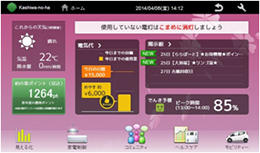
Home screen (image)
|
 |
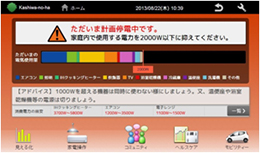
Electricity conservation request screen (image) |
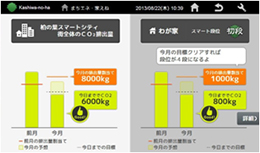
Comparison screen for home and overall town energy usage status (image)
|
 |
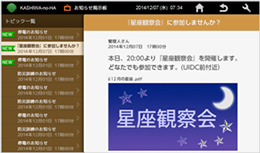
Local event information screen (image) |
Kashiwa-no-ha Smart City Initiatives in the Field of Energy
Mitsui Fudosan is developing the Kashiwa-no-ha Smart City under the concept of “An Urban Model for Our Future,” through collaboration between the public sector, private sector and academia, as an urban development designed to resolve issues for the area such as coexistence with the environment, promoting health and longevity, and fostering new industries. Mitsui Fudosan has positioned energy in particular as a key theme for supporting safe, secure, and comfortable living. In 2009, the Company began a social experiment with visualization of energy usage and CO2 emissions within residences, and in 2012 smart meters were incorporated as standard equipment on all units of the integrated residence Park City Kashiwanoha Nibangai (880 units in total). Through these initiatives the Company has accumulated data on public energy system needs, usage trends, and effectiveness of energy conservation mesasures, which has been used in the present development of the Kashiwa-no-ha AEMS and Kashiwa-no-ha HEMS.
Mitsui Fudosan is also installing duplicated lines in the energy network for distributed power supply in this area, to prepare against power cut risks. Other initatives include the installation of a solar power generator (generation output: approximately 500 kW) and large-scale storage batteries (storage capacity: approximately 11,850 kWh, output: approximately 1,800 kW (planned)) at LaLaport KASHIWANOHA. There are also plans for the mixed-use facility Gate Square, which is currently under construction, to install a solar power generator (generation output: approximately 220 kW) and large-scale lithium storage batteries (storage capacity: approximately 3,800 kWh, output: approximately 500 kW) and an emergency gas-powered generator (generation output: approximately 2,000 kW).
Looming ahead, Mitsui Fudosan will undertake construction of privately operated transmission lines for conducting electrical interchange and development of Kashiwa-no-ha Smart Center, which will serve as the control center for the area using the Kashiwa-no-ha AEMS, in order to operate a smart grid including electrical interchange. Mitsui Fudosan and Hitachi aim to extend the Kashiwa-no-ha AEMS over a wider area, while Mitsui Fudosan is also working with Sharp to develop a system for the Kashiwa-no-ha HEMS that can be easily installed in existing residences.
*1 AEMS stands for Area Energy Management System
*2 HEMS stands for Home Energy Management System
*3 The Kashiwa-no-ha AEMS system was developed through a combination of Mitsui Fudosan’s operational capabilities, Hitachi’s technical capabilities, and Nikkei Sekkei’s conceptual capabilities. The three companies have filed for patents on the system, including the operational scheme. (Patent application number: 2013-212410; date: Oct. 10, 2013; Title: Energy Management System for Adjusting Energy Supply and Demand in Multiple Districts and Energy Management Method)
*4 Kashiwa-no-ha Smart City operates a multi-transport sharing system including EVs, electric scooters, and bicycles as a low-carbon urban transport system. The Kashiwa-no-ha AEMS will link with this system to control vehicle information and the Kashiwa-no-ha HEMS will include a function for checking the usage status of the service and making reservations for vehicles.
*5 Kashiwa-no-ha Points are used in a point program that enables people to accumulate points for participating in environmental, health, creativity, and exchange activities organized by Kashiwa-no-ha Smart City. The points can be used for participating in local events, or for the transport service, shopping, and other activities.
* BCP stands for Business Continuity Plan.
* LCP stands for Life Continuity Plan.
|
|
|